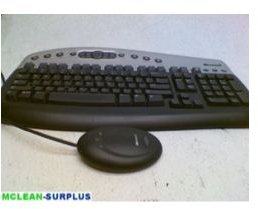How to fix Microsoft Multimedia Keyboard 1.0a Problems
Microsoft Multimedia 1.0a: But Which One?
So, it seems you need help troubleshooting your multimedia 1.0a keyboard. Simple enough, right?
Wrong, because there’s one problem: There are about ten different keyboards from Microsoft alone that bear this namesake. From the X09-50429 to the WBR0168, there really is no telling which one you have unless you bought it new and for some reason still have the box. If you do? Great. If you don’t? Don’t fret; this guide will be going over troubleshooting for all of the multimedia 1.0a models, and since (for the most part) troubleshooting is the same from model to model, it really shouldn’t matter at all whether you have the newest or the oldest!
One thing to note: If, for some reason, there is a model-specific piece of advice I want to give, I will make that known. You won’t find yourself lost no matter what you buy!
Method #1: Reconnecting
When it comes to these multimedia 1.0a things, there are two types: The wired types, and the wireless types. What you’re going to do for this step is relatively similar no matter which you have, but there is a slight difference. Read carefully so you don’t miss anything!
To reconnect your keyboard, the first thing you’ll want to do is completely shut it down. For all of you Windows 7 aficionados, this does NOT include hibernating; I mean seriously shutting it down, no matter what your friends tell you about how they’re exactly the same. After doing this, head on to the back of the tower or the side of the laptop, depending on which type of computer you’re using.
What you want to do is disconnect the cable that connects the keyboard to your laptop, and this is where things differ between wired and wireless. For a wired connection, simply follow the cord to your computer and pop the connector out, blow into it to get any dust out, and then re-insert it. If you’re using a wireless keyboard, look for your computer’s USB ports and then find the one that connects to your wireless keyboard’s receiver. If you didn’t set the receiver up, you’ll be looking for a cord that leads to a wallet-sized plastic device that probably has a few lights on it. It won’t be connected to anything else.
Once you find it, disconnect it, blow into the USB end, and then reconnect it. Start up you computer and try your keyboard again.
Method #2: Drivers Drivers Drivers

You may have heard of drivers before when looking up troubleshooting methods for other devices, but if you haven’t, here’s a quick rundown: Drivers are the piece of software that tell your computer how to handle your hardware, so that when you plug in, say, a webcam, it knows where to look and how to interpret the signals it gets from the camera. The same applies to keyboards. So why could this cause your keyboard not to work?
Well, if your drivers are out of date, your computer won’t know how to run certain hardware (including keyboards!), so you’ve gotta keep those drivers up to date. Here’s how:
- Right click on “My Computer” and select the “Hardware” tab
- Click on “Device Manager” and look on the left-hand side of the window for the list of devices
- Find the “Keyboards” section, expand it, and find your keyboard.
- Right click on the keyboard and select “Update Drivers”
- When the prompt box appears, simply choose option of letting your computer search for drivers as opposed to finding them yourself. After the search completes, continue to follow the on-screen instructions and then close it when it finishes.
- Restart your computer.
- When it starts back up, try and use your keyboard to type into a text editor like Word or Notepad!
Method #3: Switch to Another Port
Sometimes it’s not the keyboard that’s the problem, it’s the computer. Try a different USB or PS/2 port and then restart your computer and see if things work out a little better for you. Something else to watch out for: If you’re connected using a USB Hub, it can also malfunction and need repairing, so make sure you try switching from a hub to a direct port and checking to see if that makes a difference.
Method #4: The Vacuum Cleaner
The last thing I have to offer is a sort of poor-man’s version of cleaning a keyboard, but often times it works just as well as actually taking the thing apart. What you want to do is flip your keyboard upside-down, shake it a bit to remove and dust and grime that’s easily removable, and then take either a pressure hose or a vacuum cleaner turned on reverse and blast it into the cracks between the keys. This should knock and dust that’s either on the sides or underneath out of the keyboard and allow the sensors to pick up signals a little bit better.
That’s the last tip I’ve got. If you know any more, leave a comment and we’ll get it added to another article! Thanks!
References
[Image] Product Page, https://compare.ebay.com/like/140562201933?var=lv<yp=AllFixedPriceItemTypes&var=sbar&_lwgsi=y
[Image] Product Page, https://www.kpsurplus.com/microsoft-kb-0168-multimedia-keyboard-1-0a.html
[Information] Author Knowledge
[Information] eHow, How to Troubleshoot a Computer Keyboard, https://www.ehow.com/how_2318120_troubleshoot-computer-keyboard.html
